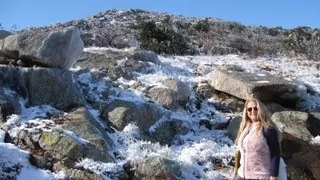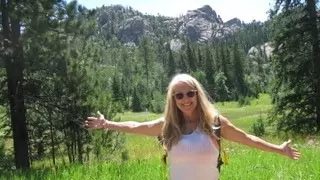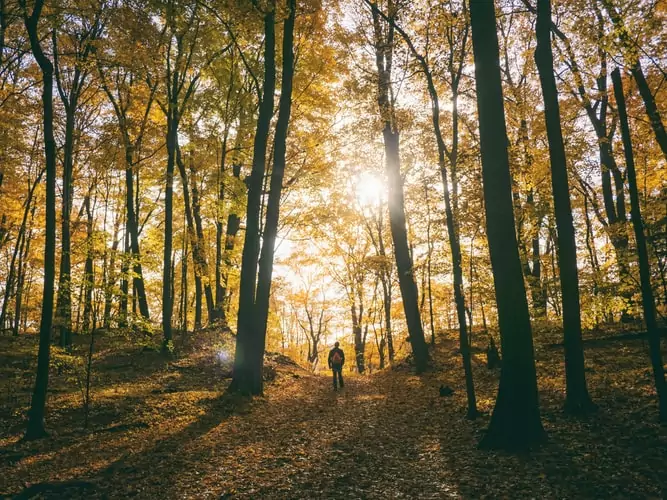I hike because it relaxes me. When I started hiking almost 20 years ago, it was for exercise. Now it is for my soul.
Hiking is hypnotic. Once I decide to do it and start walking, I realize before long a lot of time passed, and I no longer seem to focus on my worries and concerns. With my creative mind in problem solving mode, I finish the trail with solutions.
Hiking Time As Meditation
As an active person, sitting meditations are not my thing. I began to use my hikes as meditation time, focusing only on the senses. I started by noticing only the visuals, shapes, colors etc., then moved on to sounds and feelings. This practice over time made my hikes more productive on all levels; mental, emotional and physical.
Nature calls me, even when the trail is muddy, when it is 100-degrees, when it snows. I am part of the natural world, so whatever it experiences, I experience as well.

How and Why I Started Hiking
Recently divorced, and somewhat divorced from the real world as well, a date invited me to Grapevine Lake for a hike. I don’t remember much about that hike other than my date’s words of wisdom, “You hydrate before the hike, not on the trail.”
While the date wasn’t particularly memorable, I was grateful for the introduction to the North Shore Trail and continued to hike there solo weekly for about ten years – until I tired of fighting with the DORBA (Dallas Off Road Bicycle Association) riders. I hiked to release pent up anger and to connect to something greater than myself. I hiked for answers. I hiked because I didn’t have anything else to do. I hiked because I liked how my body felt when sweating and exerting energy. I liked that I was happily exhausted afterwards when I returned to my car.
Twenty years later hiking is in my DNA. I am hypnotized to hike. Like brushing my teeth, it is unconscious.
Everything Is Alive, Everything Has a Soul
In his book “Spell of the Sensuous,” David Abram introduced me to the idea of animism: Everything is alive, everything has a soul. I did several solo camping trips after reading his book and remember feeling like there was so much more on the trail than just me. Nature was alive and saying, “Hey look at me, look how I am a tree growing happily out of this rock,” “Hey look at me, I am a rock that is so large, yet gracefully balanced on a small rock.” “Hey, look at me, I am a flower with 50 bees on me and I am still smiling.” It was powerful because as I write this, I can STILL see those images in my mind’s eye.

If You Hear the Calling, Answer It
As the saying goes, “take a hike”. If you have a problem, tell yourself you want to find a solution by the end of your hike. Start off on the trail and forget about it. It may come to you while you walk, or you may realize it later. Even better, you may find the issue resolved itself seemingly on its own, but the subconscious really did that. You’ll discover, as I did, how much hiking and hypnosis have in common to help shift perspective and gain insights.
Try it. Even if it is a walk in your neighborhood. The wind longs to move through your hair.
About the Author: Valerie Grimes, CHt Clinical Hypnotist

Valerie is a master at helping people overcome their negative belief systems. false opinions, and self-defeating habits that reside in their subconscious mind. Hiking and hypnosis are both linked to mental health, so she combines the two to help you achieve your goals. Learn more here.
Interesting Parallels and Connections Between Hiking and Hypnosis
Hiking and hypnosis may seem like unrelated activities, but there are some interesting parallels and connections between the two. Here’s what our readers say are the commonalities:
Relaxation and Mindfulness
Both hiking and hypnosis can induce a state of relaxation and mindfulness. When hiking, especially in natural and serene environments, individuals often experience a sense of calmness and being present in the moment. Similarly, hypnosis aims to guide individuals into a state of deep relaxation and focused attention, allowing them to be more receptive to suggestions and therapeutic interventions.
Altered States of Consciousness
Hiking, particularly during long or challenging treks, can lead to an altered state of consciousness. Some hikers describe feelings of “flow” or a meditative-like state where their minds become deeply immersed in the activity. Similarly, hypnosis aims to create an altered state of consciousness, characterized by heightened suggestibility and focused awareness.
Stress Reduction and Well-Being:
Both hiking and hypnosis have been associated with stress reduction and improvements in overall well-being. Hiking in nature has been shown to lower cortisol levels (the stress hormone) and improve mood, while hypnosis has been used as a complementary therapy to reduce stress, anxiety, and pain.
Connection with the Subconscious Mind:
In hiking, the rhythmic and repetitive nature of walking can lead to introspection and accessing the subconscious mind. Similarly, hypnosis often involves bypassing the conscious mind to communicate directly with the subconscious, allowing for behavioral and emotional changes.
Enhanced Creativity:
Some hikers and artists find that being in nature while hiking can enhance creativity and problem-solving abilities. Similarly, hypnosis has been used to access and stimulate creative thinking and imagination.
Goal-Oriented Experiences:
Hiking and hypnosis can both be goal-oriented experiences. In hiking, individuals set goals to reach a particular destination or complete a challenging trail. In hypnotherapy, individuals may have specific goals they want to achieve, such as overcoming a fear, breaking a habit, or improving performance in a particular area.
While hiking and hypnosis are different in their execution and objectives, they share underlying psychological and physiological aspects. Both activities offer unique benefits and can contribute positively to a person’s mental and emotional well-being. It’s worth noting that while hiking is generally safe and suitable for most people, hypnosis should only be conducted by trained professionals for therapeutic purposes.
FAQs
Below are some frequently asked questions and corresponding answers about hiking.
What should I wear for hiking?
Wearing appropriate clothing is essential for a comfortable and safe hiking experience. Opt for moisture-wicking and breathable fabrics, sturdy hiking boots or shoes, lightweight and layered clothing, a hat, sunglasses, and sunscreen. Don’t forget to consider the weather conditions and pack accordingly.
How do I prepare for a hike?
Before embarking on a hike, it’s essential to plan and prepare. This includes selecting an appropriate trail for your fitness level, checking the weather forecast, informing someone about your hiking plans, packing essential gear (water, snacks like meat sticks, map, first aid kit), and ensuring you are physically prepared for the hike.
Are there different types of hiking trails?
Yes, hiking trails come in various types and difficulty levels. There are easy, moderate, and strenuous trails, as well as loop trails, out-and-back trails, and point-to-point trails. Some trails are paved, while others are natural dirt paths. Choose a trail that matches your fitness level and preferences.
How can I stay safe while hiking?
Safety is a top priority when hiking. Always stay on marked trails, carry a map and compass (or GPS), follow any posted signs and warnings, be aware of wildlife in the area, bring enough water and snacks, and let someone know your hiking itinerary. It’s also crucial to check for any trail closures or weather advisories before heading out.
Can I go hiking alone?
Hiking alone can be enjoyable, but it comes with additional risks. If you plan to hike alone, inform someone about your plans and estimated return time. Stick to well-traveled and marked trails, be cautious of your surroundings, and trust your instincts.
Do I need a permit to hike certain trails?
Certain hiking trails, especially in national parks and protected areas, may require permits. Check the trail’s official website or contact the managing authority to find out about permit requirements and how to obtain them.
How can I prevent blisters while hiking?
To prevent blisters, wear well-fitting and broken-in hiking boots or shoes. Consider wearing moisture-wicking socks designed for hiking, and use a lubricant like petroleum jelly on areas prone to blisters. Take breaks and remove your shoes to let your feet breathe during longer hikes.
Is camping allowed on hiking trails?
Camping regulations vary depending on the trail and the location. Some trails have designated camping areas, while others prohibit camping altogether. Research the specific trail and its rules regarding camping before your hike.
What should I do if I encounter wildlife during a hike?
If you encounter wildlife during a hike, maintain a safe distance and avoid approaching or feeding the animals. Respect their space and behavior. It’s essential to be familiar with the wildlife in the area and know how to respond appropriately in case of encounters with potentially dangerous animals.
Are there any hiking etiquettes I should follow?
Yes, there are some common hiking etiquettes to keep in mind. Yield the right of way to uphill hikers, stay on the trail to avoid damaging the environment, don’t disturb wildlife, and pack out all your trash. Also, keep noise to a minimum to preserve the tranquility of nature.
originally posted Jan 21, 2021
updated July 1, 2023










